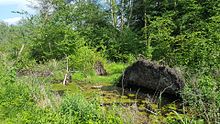Muckenbruch
The Mucke break is under nature conservation standing bog on the outskirts of Bad Westernkotten , a quarter of Erwitte in the district of Soest in North Rhine-Westphalia . It starts right on the edge of the village.
history
In earlier times, peat was cut for heating in this area . It was also banned in Mucke break for some time one or the other walkway to the superfluous, concrete ways renature .
The moor has suffered from heavy drainage for decades . In summer, this results in low groundwater levels , which lead to peat decomposition. In order to prevent this slow death of the moor and thus the further loss of valuable habitats for animals and plants, spring water, groundwater and rainwater should be retained in the moor. For this purpose, several drainage ditches were closed in 2014. As a result, the groundwater level rises again to a natural, higher level. The work on the bog soils was particularly gentle on the soil. At the same time, overflow channels in the paths ensure an even distribution of water in the moor, which is based on the natural gradient.
Protection expulsions
In 1996 the Arnsberg district government designated the Muckenbruch nature reserve with 97.1 hectares by ordinance . With the Erwitte-Anröchte landscape plan , the nature reserve (NSG) was re-designated by the Soest district council . The NSG area has been part of the FFH area Manninghofer Bach as well as Gieseler and Muckenbruch (No. DE-4315-302) and also as part of the European bird sanctuary Hellwegbörde (No. DE-4416-401) since 2004 .
Animal species
In addition to other animal species, the bullhead , marsh harrier and kingfisher have been identified in the quarry .
See also
Web links
- "Muckenbruch" nature reserve in the specialist information system of the State Office for Nature, Environment and Consumer Protection in North Rhine-Westphalia
- Detailed information on the location, history and use of the Muckenbruch on the mayor's website
Individual evidence
- ↑ Life for the Muckenbruch. The patriot . May 28, 2014. Retrieved May 26, 2017.
Coordinates: 51 ° 38 ′ 1.3 " N , 8 ° 22 ′ 47.3" E



